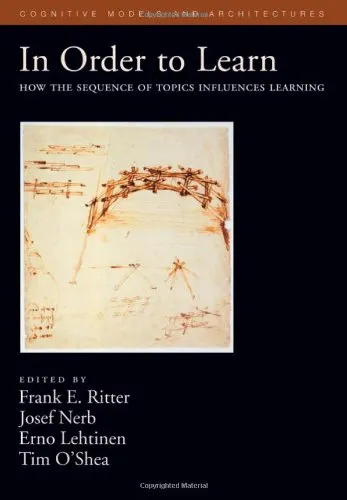In Order to Learn: How the Sequence of Topics Influences Learning
4.0
Reviews from our users

You Can Ask your questions from this book's AI after Login
Each download or ask from book AI costs 2 points. To earn more free points, please visit the Points Guide Page and complete some valuable actions.Introduction
Learning is one of the most fundamental processes that shape human development, yet the question of how to structure learning sequences to optimize understanding and retention often remains overlooked. In Order to Learn: How the Sequence of Topics Influences Learning, authored by Frank E. Ritter, Josef Nerb, Erno Lehtinen, and Timothy M. O'Shea, provides a groundbreaking exploration of how sequencing affects the learning process. This book is an essential read for educators, instructional designers, researchers, and learners alike, as it bridges cognitive science, educational psychology, and practical implementation.
Through a meticulous analysis of research and case studies, this book examines different methods of structuring learning materials, the scientific underpinnings of these strategies, and their resultant impacts on performance, comprehension, and long-term memory. It dives deep into how the order in which information is delivered significantly impacts not only immediate understanding but also how readily students can transfer that knowledge to new contexts.
Detailed Summary of the Book
The book revolves around one central question: "Does the sequence in which topics are learned matter?" Using diverse methodologies and numerous real-world examples from education and training, the authors unravel the complexities of this question. They demonstrate how different instructional sequences can result in drastically different outcomes, even when the same material is covered.
Divided into several chapters, the book systematically explores theoretical frameworks, experimental studies, and practical applications of sequencing. Key topics include "knowledge scaffolding," "task interleaving versus blocking," "the role of prerequisites," and "cognitive load theory as it relates to sequence design." The authors incorporate insights from artificial intelligence (specifically cognitive tutoring systems) and real-world classroom-based research to provide actionable insights.
Importantly, the text also addresses some common myths about learning and highlights the dangers of one-size-fits-all approaches to curriculum design. A recurring theme throughout the book is how tailored approaches to sequencing can lead to more personalized and effective education.
Key Takeaways
- The sequence in which topics are introduced can significantly influence learning outcomes, affecting not only mastery but also retention and transfer.
- Optimal sequencing considers the learner's prior knowledge, cognitive load, and the complexity of the material.
- Techniques like interleaving and scaffolding are effective strategies to enhance understanding.
- Poorly sequenced instruction can lead to gaps in knowledge or an inability to apply concepts in a practical context.
- Theories such as cognitive load and zone of proximal development form the foundation for understanding sequencing strategies.
Famous Quotes from the Book
“Learning is not just about acquiring facts; it's about understanding how those facts connect, and that connection is shaped by sequence.”
"The right sequence can make complex ideas feel intuitive, while the wrong one can make even the simplest concepts a struggle."
“Sequencing isn’t merely an organizational tool; it’s a cognitive strategy that shapes how we learn, remember, and apply knowledge.”
Why This Book Matters
In a world where education systems and corporate training programs are under constant pressure to produce better outcomes, In Order to Learn equips educators and trainers with the evidence-based knowledge they need to make informed choices about sequencing. It underscores the fact that learning is not just about what is taught, but how and in what order it is presented.
Beyond its immediate relevance to education, this book also resonates with anyone interested in cognitive science, as it sheds light on the inner workings of human memory, problem-solving, and comprehension. Whether you're a teacher seeking to improve your lesson plans, a corporate trainer designing employee workshops, or a lifelong learner trying to optimize your own learning process, this book offers a wealth of insights that are both practical and thought-provoking.
By tackling the often-overlooked topic of sequence in learning, this book fills a vital gap in educational literature, making it a critical resource for anyone invested in the science and art of learning.
Free Direct Download
You Can Download this book after Login
Accessing books through legal platforms and public libraries not only supports the rights of authors and publishers but also contributes to the sustainability of reading culture. Before downloading, please take a moment to consider these options.
Find this book on other platforms:
WorldCat helps you find books in libraries worldwide.
See ratings, reviews, and discussions on Goodreads.
Find and buy rare or used books on AbeBooks.


